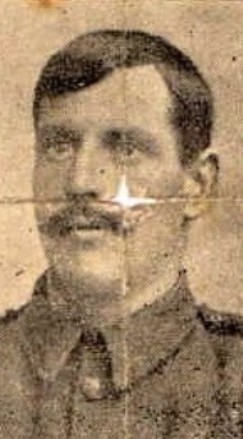
Information provided by Roger and Helen Raisbeck.
Percy Charles Perry was born on 22 June 1886 to George and Selina Perry in Dorset, England. In 1902, at the age of 16, he joined the 5th Battalion of the Coldstream Guards at Yeovil (probably transferring to London before 1905). In 1905 he transferred to the army reserve (and enlisted again in 1914 service number 18562, Coldstream Guards). He fought at the Battle of Mons which was the first major action of the British Expeditionary Force (BEF) in the First World War. He was wounded in action and hospitalised. He sent a photograph postcard home to his wife, Lucy, simply saying “I am first on your left [in the picture], going alright, PP”. Unfortunately he was unable to return to action and was discharged on 7 October 1915.
He qualified for the 1914 Star (also known as the Mons Star) on 13 August 1914 as well as being awarded the British War medal and the Victory medal.
Percy had 5 brothers, 4 of which joined the navy. One of his younger brothers, Ernest Sydney Perry, was lost in the Battle of Coronel off the coast of Chile on board HMS Monmouth on 1 November 1914. A newspaper cutting calling the Perrys a “Family of Patriots”, shows Percy in the centre flanked on either side by his brothers. Percy returned to civilian life back in England after his discharge in 1915 and encouraged his daughter Edna May Perry to knit socks for soldiers as part of the war effort.
Percy died in March 1944 at the age of 57 in his home county of Dorset.


Explore more memories from the ribbon
-
Rees Brothers
George Frederick Gywn Rees and his younger brother Charles Bernard Russell Rees from Leicestershire both joined the Yorkshire Regiment during the First World War. Their parents, Sydney and Margaret Rees were relatively wealthy and they lived in Sheffield for much of their childhood. Sydney was a Church of England clergyman. Born only 1 year apart, George in 1895 and Charles in 1896, it would appear that they took similar paths through their early life. In the 1911 census they were both recorded as living at a boarding school in Workshop along with several hundred other boys. George and Charles both joined the 5th Battalion of the Yorkshire Regiment in 1915. Unfortunately their service records do not appear to have survived but museum records track their military careers from 1915 to 1918. George was wounded twice, in November 1916 and in June 1917, but neither wound appears to have affected his career as he was promoted to acting Captain in July 1917. Charlie however appears to have made it through the war relatively unscathed. Other than various promotions he is not listed until June 1918 as missing, turning up as a Prisoner of War in September. He returned home in late 1918 to Scrayingham Rectory, Stamford Bridge, York. Charles’ medal card records that he received the Victory Medal and the British War Medal. Both brothers survived the war but we do not know what happened to them later in life.
-
Samuel Kirk Lambert
Samuel was born in 1894 at Askrigg. His mother, Frances, was 20 years old and single. However, 5 years later she married Wilfred Kirk, the likely father of Samuel though the 1911 census has Samuel down as a ‘stepson’. Wilfred was some 20 years senior to Frances and a farmer. They would have four more children, all girls. However, the 1911 census only shows two daughters as being listed. Samuel attended Hardraw School and worked on the family farm. Samuel enlisted at Leyburn in June 1916 joining the 6th Battalion Yorkshire Regiment. The Battalion went to France later that year. On November 1st 1917 the Battalion was in the support line SE of Loos in northern France. Between the 4th and the 6th work was spent on improving the Battalion trenches. On the 9th Samuel and his colleagues were helping in the preparations for a raid, cutting wire and ladder placements. On the evening of the 9th during heavy shelling Samuel was badly wounded. He was taken to a Casualty Clearing Station near Bethune. On the night of the 12th November Private Samuel Kirk Lambert died. He is buried in Choques Military Cemetery.
-
L Cpl Thomas M Coates
Thomas was born around 1883 to George and Margaret Coates. George was a farm worker. By 1901 the family was living at Marsett in Raydaleside where Thomas and his two brothers, George and Albert were born. The children attended Stalling Busk School. On leaving school Thomas worked in the Council Offices in Hawes. Thomas enlisted on the 6th October 1915 joining the 4th Battalion Yorkshire Regiment. Thomas would gain the rank of Lance Corporal. On the 26th September 1916 during the latter part of the Somme offensive Thomas won the Military Medal for bravery in the field. However, he was severely wounded. On an attack of a German trench a soldier threw a stick bomb which exploded at Thomas’s feet whereby he received serious wounds to his leg and face. Despite this he still managed to dispatch the German soldier with his bayonet and in doing so saved a colleague. Thomas spent 11 weeks at a hospital at Rouen where he underwent four operations. Two more operations followed in England before he was discharged from the Army on the 14th July 1917. Thomas eventually went back to his old job until he married Elizabeth Watson in 1921. They then went to live at The Heugh, a large isolated house above Nappa Scar near Settle in the Yorkshire Dales. They ran it as a guest house, and it was here that their two daughters, Margaret and Mary, were born. On the 21st January 1925, after only three day’s illness, Thomas died…
